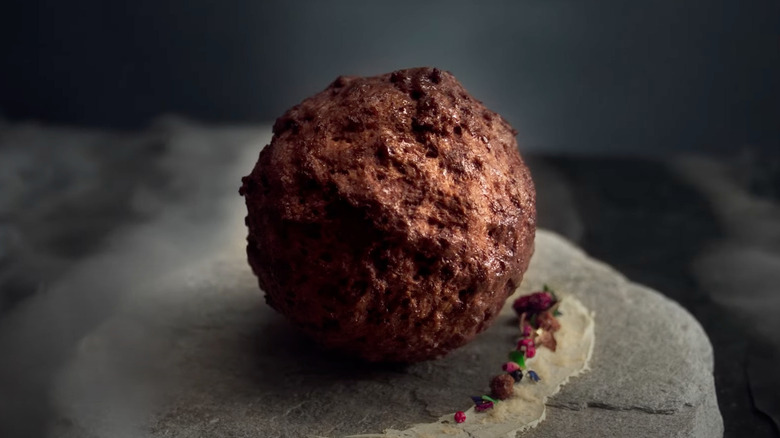A Meat Startup Revived The Wooly Mammoth In Meatball Form
Good news if you're on the Paleolithic diet, you just got one step closer to truly eating like our nomadic ancestors. In a scientific breakthrough that feels straight out of the movie "Jurassic Park," scientists at a meat startup, Vow, have used DNA from the extinct woolly mammoth to recreate mammoth meat, per CNN. What hasn't been cooked in thousands of years has now been formed into a compact meatball. This resurrection project stems from Vow's mission statement to help introduce the world to the positive benefits of cultivated meat.
An Australia-based company, Vow first intended to use the extinct dodo bird as their test subject but lacked the proper amount of DNA needed. Their sights soon landed on the woolly mammoth, which fortuitously has several perfectly preserved remnants thanks to Ice Age permafrost. Vow intended the focus to remain on an animal that had been driven to extinction through both human expansion and environmental factors, working as a larger metaphor for the way that the meat industry is currently damaging our environment. So how did this prehistoric meat become reborn in a lab in the 21st century?
A lost meat, rediscovered
Again, it feels like the successful experiment comes straight out of the "Jurassic Park" playbook. Scientists sequenced as much of the genome of the mammoth as they could, patching missing pieces with African elephant genes, to create a mammoth myoglobin protein, a protein that gives meat its flavor, as reported by CNN. Then, once this hybrid mammoth protein was produced, they inserted it into lamb muscle cells, eventually growing into synthesized mammoth meat. Still, the mammoth portion of the meat is infinitesimal in regard to the lamb genes — roughly one in 25,000.
There are some unique concerns in consuming meat that hasn't been eaten in close to 5,000 years, namely how it will affect the modern human body's allergens and immune system. For this reason, the mammoth meatball isn't up for consumption just yet. Instead of starring on a ritzy restaurant menu, this prehistoric meatball is currently being worked into a display at the Rijksmuseum Boerhaave in the Netherlands, a museum devoted to the natural sciences and medicine.
However, soon you'll have the opportunity to taste Vow's other handiwork, cultivated Japanese quail, in Singapore restaurants. Other exciting projects on the horizon include experiments with peacocks, kangaroos, and crocodiles. And a mammoth meatball that's safe for consumption isn't completely out of the question, as professor Ernst Wolvetang, the mind behind the mammoth protein, admitted to The Guardian that a safe-to-eat meatball could easily be created.

